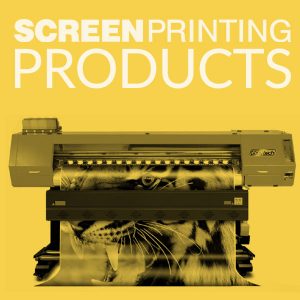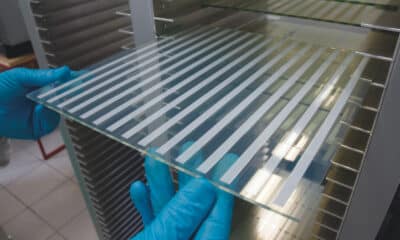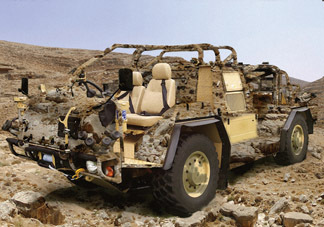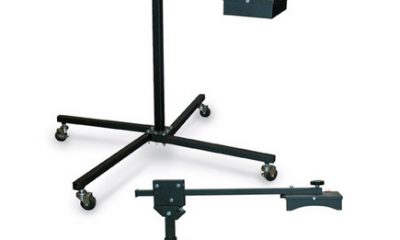Prepress & Screen Making
Published
18 years agoon
Screen printing is just an elaborate, highly developed form of stenciling that can be traced all the way back to the cave paintings of our Stone Age ancestors. Some early Neolithic graphics engineer must have been delighted to discover that if he cut a shape in a large leaf and held it up against the wall, he could apply colorants in a way that enabled the image to be repeated endlessly until the leaf finally broke down. I am sure there were heated conversations around the campfire about the best leaf to use and which kind of charcoal produced the best designs.
Another early form of stenciling was developed in the caves of Lascaux in France and Altamira in Spain. It involved using stencils and blowpipes for applying the colorants, and the very haunting images created in this way have lasted thousands of years. These same techniques have been used for millennia to decorate apparel on many islands of the Pacific. Stenciling reached the level of high art in the Indonesian archipelago when it was combined with batik (a type of decoration using wax to isolate areas of the cloth from the dying process). What we know today as the Hawaiian shirt with all its vibrant colors and repetitive shapes and patterns can be traced back directly to these processes developed through generations of trial and error.
In the middle ages, stencils were used as a cheap method to mass produce playing cards. If you take a close look at the symbols used by Hoyle today, you can see how they were perfected hundreds of years ago to facilitate their use in the stenciling process. The shapes of the heart, spade, diamond, and club are both readily recognizable and easy to cut out to create the stencil needed to produce the cards. Could your own team of graphic artists come up with such an elegant and efficient solution to this design problem?
Wallpaper became chic early on in the 17th century, and stencils were used to help decorate the elegant homes of the rich and famous. Stencils were also used in the flocking process to transfer glue in the shape images onto paper, which was then sprinkled with wool dust to reveal embroidery-like designs. You can still see many examples of this craft in the surviving colonial-era houses of Williamsburg, Philadelphia, and Boston.
Meanwhile, a process was developed in Japan and China that used silk held between two pieces of strong, waterproof paper with stencils cut in them. The paper was glued together, leaving the silk exposed to allow the paint to flow through. Slowly but surely, the screen print was being born.
The process we know today
To find out how screen printing began to take its present form, we must fast forward to Manchester, England at the start of the 20th century. A young sign painter named Samuel Simon was admiring some of those early Asian screen prints and after inquiring about the process realized that it could possibly revolutionize his business if he could somehow figure out a way to apply it in his daily work. He perfected a rudimentary wooden frame with silk stretched over it and developed an emulsion that could be painted on to block out the images on the screen. He discovered that he could print signs endlessly, turning a labor-intensive task into an efficient, new process that soon became known as silk screening.
In 1907, this young man was rewarded for his efforts with what is recognized by many as the first patent for the screen-printing process. Not content to rest on his laurels, he set out across the country to teach signmakers about the benefits and the potential profits that could be realized through this new form of printing. Silk-screened images would soon after be found in towns and cities across Europe and the rest of the world.
It took an enterprising American, John Pilsworth of San Francisco, to realize a few years later that he could combine several different stencils on several different screens with several different colors to produce a multicolored image. His new process sparked the poster revolution of the first world war and made the silk-screened image of Uncle Sam urging the young men of America to join their brothers in the trenches as familiar to us now as it was to our great grandfathers and great grandmothers.
This method of printing, which had come to be known in the art world as serigraphy, was used by many of the best graphic artists of the Art Deco and Art Nouveau movements of the 1920s. Some of the finest art of the day was produced on screen-printing presses.
By the time the second world war rolled around, Hollywood had jumped onto the bandwagon, and thousands of movie posters were screen printed every week and hung in the movie palaces that sprung up across America. History doesn’t tell us who first decided that screen printing was the best way to mass produce these posters, but we do know that he saved his employers a ton of money.
When the new GIs climbed aboard their landing crafts on D-Day, they were all wearing shirts with the words “U.S. Army Property” screen printed on them. Their tanks also sported identification numbers applied by way of screen, stencil, and squeegee. Somewhere in the teeming ranks of America’s servicemen there was a quartermaster or perhaps a procurement officer that recognized that this was the way to get these jobs done in the most efficient and economical way possible. There was a war going on, and this kind of innovative use of technology was going to help the allies win.
Screen printing as an industry
After World War II, the silk used in parachutes was replaced by a new polymer called polyester that was much cheaper to make and proved to be much more reliable, much stronger, and most importantly, reusable. It wasn’t long before some enterprising, young, screen-printing engineer decided to see whether this new product would work as well for his industry as it had for the modern paratrooper. By this point, photographic techniques for screenmaking also were perfected with the development of photo-imaging emulsions and dry-film applications that allowed us to speed up the screenmaking process by leaps and bounds.
As 1960s arrived, the era of the transistor brought with it the need to efficiently produce the circuits used in manufacturing the machines of the electronics age. The screen-printing process proved to be the best way to do this, and the printed circuit board (PCB) was born. Without screen printing, the high-volume production of the PCBs would not likely have been possible

Subscribe

Magazine
Get the most important news
and business ideas from Screenprinting Magazine.
Most Popular
-

 Case Studies2 months ago
Case Studies2 months agoHigh-Density Inks Help Specialty Printing Take Center Stage
-

 Art, Ad, or Alchemy2 months ago
Art, Ad, or Alchemy2 months agoF&I Printing Is Everywhere!
-

 Andy MacDougall2 months ago
Andy MacDougall2 months agoFunctional and Industrial Printing is EVERYWHERE!
-

 Columns3 weeks ago
Columns3 weeks ago8 Marketing Mistakes Not to Make When Promoting Your Screen Printing Services Online
-

 Editor's Note2 weeks ago
Editor's Note2 weeks agoLivin’ the High Life
-

 Marshall Atkinson2 weeks ago
Marshall Atkinson2 weeks agoHow to Create a Winning Culture in Your Screen-Printing Business
-

 Thomas Trimingham2 months ago
Thomas Trimingham2 months ago“Magic” Marketing for Screen Printing Shops
-

 News & Trends2 months ago
News & Trends2 months agoWhat Are ZALPHAS and How Can You Serve Them in Your Print Business?




